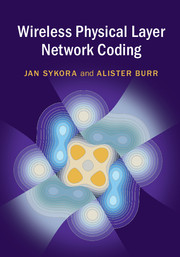Book contents
- Frontmatter
- Contents
- Preface
- Mathematical Symbols
- Abbreviations
- Part I Motivation and Gentle Introduction
- Part II Fundamental Principles of WPNC
- Part III Design of Source, Relay, and Destination Strategies
- 6 NCM and Hierarchical Decoding Design for H-MAC
- 7 NCM Design and Processing for Parametric Channels
- 8 NCM Design for Partial HSI and Asymmetric H-MAC
- 9 Joint Hierarchical Interference Processing
- 10 WPNC in Complex Stochastic Networks
- Appendix A Background Theory and Selected Fundamentals
- References
- Index
9 - Joint Hierarchical Interference Processing
from Part III - Design of Source, Relay, and Destination Strategies
Published online by Cambridge University Press: 01 February 2018
- Frontmatter
- Contents
- Preface
- Mathematical Symbols
- Abbreviations
- Part I Motivation and Gentle Introduction
- Part II Fundamental Principles of WPNC
- Part III Design of Source, Relay, and Destination Strategies
- 6 NCM and Hierarchical Decoding Design for H-MAC
- 7 NCM Design and Processing for Parametric Channels
- 8 NCM Design for Partial HSI and Asymmetric H-MAC
- 9 Joint Hierarchical Interference Processing
- 10 WPNC in Complex Stochastic Networks
- Appendix A Background Theory and Selected Fundamentals
- References
- Index
Summary
Introduction
This chapter deals with a very WPNC specific problem. It can be explained with reference to the classical interference mitigation technique, where we utilize the knowledge of the codebook and the signal space structure of the interfering components in order to minimize their impact on the desired data. But in the WPNC solution context provided in this chapter (cf. Chapter 8), it has two fundamental distinguishing aspects. First, the structure of the interfering and/or the desired signals/codebooks is not known uniquely. Both of them are allowed to be hierarchical codebooks which have multiple signal space representations of H-data. Second, the interfering and desired signals are not independent. They share some common, potentially hierarchical-only information, and we expect that they can support each other – it creates a friendly hierarchical interference. These aspects, the hierarchical self-dispersion and supporting aspects of the interaction, require us to adopt a fundamentally different approach including a revisiting of some coding theorems. We will show that friendly hierarchical interference can help in the desired data decoding. We will show the solutions for both Compute and Forward and Layered NCMs.
Joint Hierarchical Interference Processing
A relay in a WPNC network can receive signals from many component nodes. Some system scenarios allow us to define and utilize (particularly in the HDF class of scenarios) multiple HNC maps at one receiving relay. For example, the CF-based NCM fulfills the isomorphic property for multiple HNC map coefficient sets. Another example is a specific case corresponding to the structured scenarios of Chapter 8, where several subsets of real or virtual component nodes form multiple NCMs. However, the situation is specific in the sense that the component messages for these multiple HNC maps are independent and we observe signals internally coupled by HNC maps as a superposition. The system model treated in this chapter assumes that the multiple maps are generally defined over a common set of component messages. In all these cases, we can utilize the fact that the signals have defined multiple internal mutual structures (formed by NCMs) and can be used to help the relay processing. In order to clearly distinguish this case, we will call it Joint Hierarchical Interference Processing.
- Type
- Chapter
- Information
- Wireless Physical Layer Network Coding , pp. 251 - 269Publisher: Cambridge University PressPrint publication year: 2018



